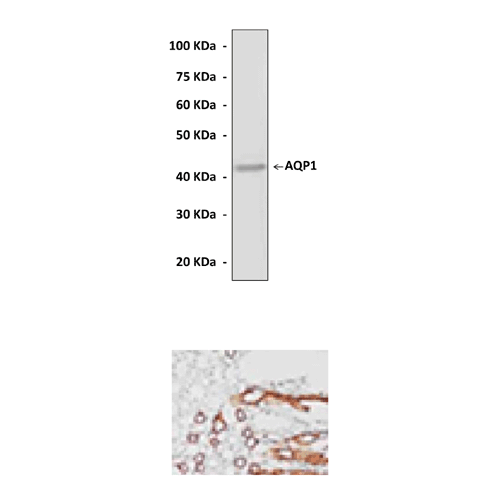Anti-AQP1: Polyclonal Aquaporin 1 Antibody |
 |
BACKGROUND Aquaporins (AQPs) are membrane water channels that play critical roles in controlling the water contents of cells. These channels are widely distributed in all kingdoms of life, including bacteria, plants, and mammals. More than ten different aquaporins have been found in human body, and several diseases, such as congenital cataracts and nephrogenic diabetes insipidus, are connected to the impaired function of these channels. They form tetramers in the cell membrane, and facilitate the transport of water and, in some cases, other small solutes across the membrane. However, the water pores are completely impermeable to charged species, such as protons, a remarkable property that is critical for the conservation of membrane's electrochemical potential, but paradoxical at the same time, since protons can usually be transfered readily through water molecules. Water molecules passing the channel are forced, by the protein's electrostatic forces, to flip at the center of the channel, thereby breaking the alternative donor-acceptor arrangement that is necessary for proton translocation.1
AQP1 is the predominant and least specialized subtype. It plays a major role in constitutive water transport through the membranes of several cell types including endothelial cells, red blood cells, and renal proximal tubule cells. It has been shown that AQP1 may also function as a cyclic nucleotide-gated cation channel that is activated mainly by cGMP and indirectly also by cAMP. It was reported that AQP-1 transports small gas molecules such as carbon dioxide and NO in cells.2 Moreover, ion currents of native aquaporins were confirmed in choroid plexus epithelium and shown to modulate fluid transport of those cells. Furtheremore, it was shown that PKC positively regulates both water permeability and ionic conductance of AQP1 channels.3
AQP1 is the predominant and least specialized subtype. It plays a major role in constitutive water transport through the membranes of several cell types including endothelial cells, red blood cells, and renal proximal tubule cells. It has been shown that AQP1 may also function as a cyclic nucleotide-gated cation channel that is activated mainly by cGMP and indirectly also by cAMP. It was reported that AQP-1 transports small gas molecules such as carbon dioxide and NO in cells.2 Moreover, ion currents of native aquaporins were confirmed in choroid plexus epithelium and shown to modulate fluid transport of those cells. Furtheremore, it was shown that PKC positively regulates both water permeability and ionic conductance of AQP1 channels.3
REFERENCES
1. Jensen, M. Ø. Et al: Structure 9:1083-1093, 2001
2. Herrera, M. et al: Hypertension.48:157-64, 2006
3. Zhang, W. et al: J. Biol. Chem. 282:20933-40, 2007
2. Herrera, M. et al: Hypertension.48:157-64, 2006
3. Zhang, W. et al: J. Biol. Chem. 282:20933-40, 2007
Products are for research use only. They are not intended for human, animal, or diagnostic applications.
Параметры
Cat.No.: | CA0648 |
Antigen: | Synthetic peptide corresponding to a sequence mapping near the C-terminal of human AQP1 |
Isotype: | Affinity-Purified Rabbit Polyclonal IgG |
Species & predicted species cross- reactivity ( ): | Human, Rabbit, Rat, Mouse |
Applications & Suggested starting dilutions: * | WB 1:500 to 1:1000 IP n/d IHC (Paraffin) 1:50 to 1:200 ICC n/d FACS n/d |
Predicted Molecular Weight of protein: | 42 kDa |
Specificity/Sensitivity: | Does not cross-react with other related members |
Storage: | Store at 4° C for frequent use; at -20° C for at least one year. |
*Optimal working dilutions must be determined by end user.
Документы
Информация представлена исключительно в ознакомительных целях и ни при каких условиях не является публичной офертой








